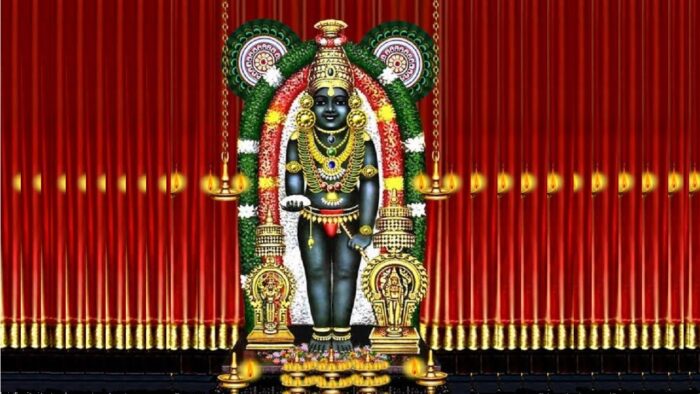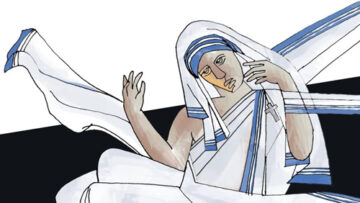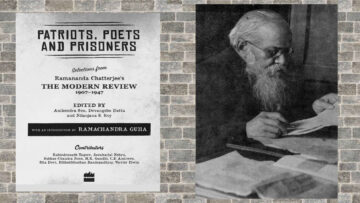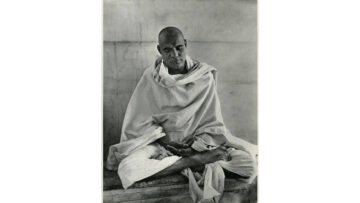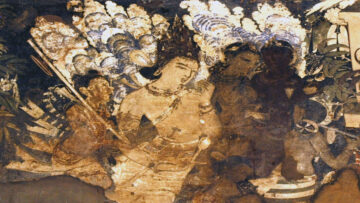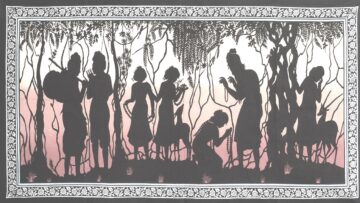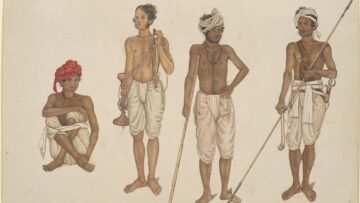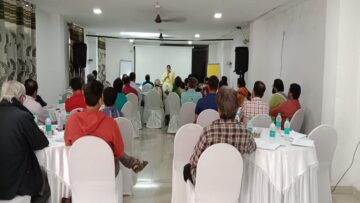॥Śrīkṛṣṇāyaparabrahmaṇenamaḥ॥
Nārāyaṇīyam is one of a kind divine confluence of a kṣetra[1], bhakta and his bhakti. This extraordinary outpouring of Kṛṣṇa bhakti in the form of a Sanskrit poem was composed by ŚriMēlputtūrNārāyaṇaBhaṭṭatiri, a Kṛṣṇa bhakta par excellence at the divine Kṛṣṇakṣetra, Guruvāyūr. The main deity of Guruvāyūr or Gurpavanapurakṣetra is Guruvāyūrappan, a kiśorapūrṇāvatāra form of ŚriKṛṣṇa. Bhaṭṭatiri describes this form as दिव्यकैशोरवेषम् (divyakaiśoraveṣam) – a young divine form with four arms wielding शङ्खचक्रकौमोदकीसरसिजं (śaṅkha, cakra, kaumodakī and sarasijaṃ) – the conch, disc , mace and lotus in each palm. Below is the beautiful dhyana śloka of Nārāyaṇīyam that at once, evokes the divine form of ŚriKṛṣṇa.
पीताम्बरंकरविराजितशङ्खचक्रकौमोदकीसरसिजंकरुणासमुद्रम्।
राधासहायमतिसुन्दरमन्दहासंवातालयेशमनिशंहृदिभावयामि॥
pītāmbaraṃkaravirājitaśaṅkhacakrakaumodakīsarasijaṃkaruṇāsamudram।
rādhāsahāyamatisundaramandahāsaṃvātālayeśamaniśaṃhṛdibhāvayāmi॥
The Lord of vātālaya (Guruvāyūr) who is dressed in yellow silk , wielding śaṅkha, cakra, kaumodakīand sarasijain his hands,With the most adoring smile on his face, who has Radha as his aid, is always in heart and head (in thoughts).
KṛṣṇaKṣetraGuruvāyūr
Today’s Gurpavanapurakṣetra or Guruvāyūr is a municipal temple town in Thrissur district of Kerala. However, its antiquity is as old as time itself. In NaradaPurana there is a reference to a certain VigrahaRoopa of Mahāvishnu being worshipped through the unbroken lineage of Lord Brahma followed by a Prajapati named Sutapas and then by Rishi Kashyapa and eventually by Vasudeva, father of Lord Krsna.
[Anjana Shila]
This Vigraha of Mahāvishnu or Adi Keshava in the form of a young boy was worshipped by the Yadava Clan as their primary deity. At the end of Krsnavatara, as Dwaraka submerged underwater, Mahāvishnu himself ordained Deva Guru Brihaspati to move the idol to a safer place. Brihaspati, then sought the help of his disciple Vāyu to retrieve the vigraha. Both Guru and Vāyu then traveled all over the world looking for an ideal place. Paraśurāma, an avatar of Mahāvishnu, invites Guru-Vayu to Kerala, a piece of land that he has extracted from the sea. Having arrived here, Guru and Vayu are further blessed by ShankaraBhagawan who vacates his place of meditation to make way for the consecration of this Mūlavigraha. ShankaraBhagawan also ordains that in remembrance of the efforts of Brihaspati and the wind-God Vāyu, this hamlet be known henceforth as Gurupavanapura or Guruvāyūr . A śloka from the Puranas says: सुराचार्यत्वयानेनवायुनाचनिमित्ततः।आरब्धमेतत्क्षेत्रंस्यात्गुरुवायुपुराभिधम्॥ (surācāryatvayānenavāyunā ca nimittataḥ।ārabdhametatkṣetraṃsyātguruvāyupurābhidham॥ Brihaspati, The teacher of Surās along with Vāyu established this kṣetra , henceforth to be known as Guruvāyupura).
It is interesting to note that Lord Shiva having vacated his place for Lord Krsna continues to grace the region albeit at a stone’s throw from Guruvāyūr, today known as Mummiyūr. However, Mahadeva’s consort Bhagavati continues to stay in a small shrine (EdatharikathuKavu) as an upadevata, right next to the Garba Griha at Guruvāyūr. Bhaktas, after completing their darshana of Guruvayurappan and Bhagavati within the temple complex, also stand in the direction of Mummiyūr and pray. A visit to Guruvāyūr is not said to be complete unless one also visits Mummiyūr. This co-existence of Hari and Hara in a kṣetra is very commonplace in Bhārat. Another wonderful aspect of BhāratīyaKṣetraparaṃparā is the significance of bhaktas associated with almost every punyakṣetra. Anyone who visits Guruvāyūr is bound to come in contact with life and legacy of several Kṛṣṇabhaktas from centuries ago to recent past. Kurooramma, Poonthanam, Narayana Bhattatri and ChembaiVaidyanathaBhagavatar are almost synonymous with Guruvāyūr. Amongst these, Shri MēlputtūrNārāyaṇaBhaṭṭatiri is certainly the most popular. Bhaṭṭatiri refers to Guruvāyūr by many names such as Gurupavanapura, or just Pavanapura, Vātālaya, Mārutapura, Marudālaya, Vātageha etc. The emphasis on pavana/vāyu/vātā/māruta indicates that Guruvāyūr was also popular as a healing destination for anyone suffering from vāyu /vātā (wind) related ailments as per āyurveda. It is in fact this ailment that brought a despondent NārāyaṇaBhaṭṭatiri to Guruvāyūr.
Kṛṣṇa Bhakta Shri MēlputtūrNārāyaṇaBhaṭṭatiri
NārāyaṇaBhaṭṭatiri belongs to the sixteenth century and hails from a place called Mēlputtūr around 50kms from Guruvāyūr. Born in the prominent Bhaṭṭatiri family, a young Nārāyaṇa eventually came under the tutelage of a great scholar by the name AchyuthaPiśorady. Guru Piśorady was an erudite scholar and a vaiyākaraṇapar excellence (Sanskrit grammarian). Having completed his studies under the Guru, NārāyaṇaBhaṭṭatiri took to composing small and big literary works which were both academic and devotional in nature. A strange turn of events led a twenty five year old Bhaṭṭatiri to contract a peculiar rheumatic pain or vātadośa that his teacher Piśorady was ailing from. Vātadośa, as per ayurveda, is an ailment caused by imbalance of vāyuor wind in the body. It is extremely painful and causes severe restrictions to movement of limbs. Someone told Bhaṭṭatiri to visit the KṛṣṇaKṣetraGuruvāyūr, famous for healing its yatrisfrom all kinds of maladies.
NārāyaṇaBhaṭṭatiri walked for several days in utter pain to finally reach Guruvāyūr . As soon as he set foot on the soil of Guruvāyūr, his joy knew no bounds. The very sight of the ŚriKṛṣṇa’smūlavigraha in its pūrnavatara, standing here at this puṇyakṣetra since time immemorial, inspired him to compose the thousand plus shlokas that together, we know today as Nārāyaṇīyam. Standing in front of the deity, Bhaṭṭatiri composed one hundred daśakas (daśaka -set of around 10 ślokas everyday) day after day. It is believed that on the day Bhaṭṭatiri composed the hundredth daśka, Guruvāyūrappan answered to his bhakta’s ardent prayers. On that day, ŚriKṛṣṇa manifested in all his glory from head to toe केशादिपादान्तरूप (keśādipādāntarūpa) and blessed Bhaṭṭatiri with आयुरारोग्यसौख्यम् (āyurārogyasaukhyam) – a long life filled with health and happiness. NārāyaṇaBhaṭṭatiri went on to live a disease free long life after this incident. While some say he lived beyond 100 years, others say it is a more realistic 80 plus years. The last word of the very last verse in the hundredth daśaka is आयुरारोग्यसौख्यम्. The genius of Bhaṭṭatiri is evident in the fact that ‘आयुरारोग्यसौख्यम्’ in the ka-ta-pa-yadi (alpa-syllabic-numeral) system translates to 1712210 – as number of days since the start of Kali Yuga as per the Malayalam calendar when the great work Nārāyaṇīyam completed! (The Gregorian date is November 27 1587 or 28th day of vrishchikam in 763 kollam year as per Malayalam calendar.)
But the true genius of Bhaṭṭatiri lies in his dexterity to reduce Vyasa’s magnum opus Srimad Bhagavatam to just around thousand verses. By no means Bhaṭṭatiri has simply summarized, simplified or cut down the size of the massive literary work. Instead, like a cold-press juicer, he has extracted the essence of Bhagavatam in a fresh and delectable form.
Nārāyaṇīyam – The Ultimate Kṛṣṇakatha
Nārāyaṇīyam or Śrīmannārāyaṇīyaṃ, is a household phenomena in most of Kerala and Tamilnadu but is little known elsewhere. However, the people of these two states have carried this poetic legacy of NārāyaṇaBhaṭṭatiri wherever they have migrated in the world. However, in the last few decades, Nārāyaṇīyamhas gained popularity amongst other Kṛṣṇa bhaktas of the world. Bhaṭṭatiri refers to his own work as ‘द्वेधानारायणीयं – dvedhānārāyaṇīyaṃ’ (N.100.11) meaning this is ‘Nārāyaṇīyam in two ways’; 1. About BhagawānNārāyaṇa and 2. Composed By Nārāyaṇa (himself). Comprising of 1034 verses arranged into a hundred cantos or daśakams, Nārāyaṇīyam is one of the finest works in Sanskrit literature. The verses of Nārāyaṇīyam are extremely intimate in nature wherein the poet is directly addressing the lord. This second person narrative also creates an intimate experience for anyone who reads Nārāyaṇīyam. Apart from its literary merits, it has also gained immense popularity for its healing benefits. Many undertake the chanting of Nārāyaṇīyam with the firm belief that they will be rid of all their diseases and ailments. Whatever the reasons, there is no doubt that a reading of Nārāyaṇīyam will bring you one step closer to ŚriKṛṣṇa. The beauty of Nārāyaṇīyam is that it is both a stuti (prayer) and a kathā (story).
In the stuti form, Bhaṭṭatiri seeks विश्वपीड़ापहत्यै – viśvapīḍāpahatyai and आयुरारोग्यसौख्यम् – āyurārogyasaukhyam[2]. Bhaṭṭatiri not only seeks the end of viśva-pīḍā – every kind of sufferings in this world but also repeatedly asks Guruvāyūrappan for āyurārogyasaukhyam for himself, a long life free of the chronic rheumatism. The last verse in each of the hundred daśakas pleads Guruvāyūrappan to take away the maladies of the composer in as many words like māṃtrāyasvasarvāmayāt, nirundhirogān, mama rogarāśiṃnirundhi , rogaughaṃpraśamaya, tāpānmamāpākuru, pāhimāmāmayebhyah etc.
The first few daśakas are almost all stutis wherein Bhaṭṭatiri showers glorious praises on Guruvāyūrappan in the most articulate Sanskrit. The opening verse starts with ‘सान्द्रानन्दावबोधात्मकमनुपमितं’ sāndrānandāvabodhātmakamanupamitaṃ and refers to Guruvāyūrappan as sāndrānanda (supreme bliss or ānanda ) , avabodhātmaka (universal consciousness) that is anupamitaṃ(unparalleled). Bhaṭṭatiri describes the unbridled emotion of finally experiencing the joy of something the mankind strives for thousands of years to just catch a glimpse often to no avail and yet, it is something so accessible to him with great ease at Guruvāyūr.
सान्द्रानन्दावबोधात्मकमनुपमितंकालदेशावधिभ्यां
निर्मुक्तंनित्यमुक्तंनिगमशतसहस्रेणनिर्भास्यमानम्।
अस्पष्टंदृष्टमात्रेपुनरुरुपुरुषार्थात्मकंब्रह्मतत्वम्
तत्तावद्भातिसाक्षाद्गुरुपवनपुरेहन्तभाग्यंजनानाम्॥N 1.1
sāndrānandāvabodhātmakamanupamitaṃkāladeśāvadhibhyāṃ
nirmuktaṃnityamuktaṃnigamaśatasahasreṇanirbhāsyamānam।
aspaṣṭaṃdṛṣṭamātrepunarurupuruṣārthātmakaṃ brahma tatvam
tattāvadbhātisākṣādgurupavanapurehantabhāgyaṃjanānām॥N 1.1
This first verse opens the floodgate of bhakti contained in the rest of the verses of Nārāyaṇīyam. Composed in sragdharā, the 21-syllabled meter which by mere chanting evokes the positive feeling of well-being, each of the verses in the first daśaka is a solicitation to the lord. The following two daśakas (2 and 3) set in śārdūlavikrīḍita and śikhariṇī respectively describe bhagavadrūpa and bhaktisvarūpa – the nature of supreme being and devotion.
From the fifth daśaka onwards, the verses take the form of Kṛṣṇakatha, the ultimate story of ŚriKṛṣṇa. In the story form, Bhaṭṭatiri provides a masterclass in abridging the entire Bhagavata Mahapurana, more popularly known as Srimad Bhagavatam, into a brilliant succinct form. There is a lore that ThunchaththuEzhuthachan, another ardent devotee of Guruvayurappan and a great scholar advised a confounded NārāyaṇaBhaṭṭatiri to ‘start with the fish’ to get his creative juices flowing. This seemingly cryptic message got NārāyaṇaBhaṭṭatiri to seek inspiration in different avatars of ŚriKṛṣṇa starting from the fish form, matsyāvatāra. This is perhaps the moment when NārāyaṇaBhaṭṭatiri decided to retell the essence of Srimad Bhagavatam.
Much like Bhagavatam, bhakti is the central theme and emotion of Nārāyaṇīyam. However very much like its inspiration, it also has its fair share of profound philosophy detailing the nature of ashtanga yoga siddhi (daśaka-5), karma mārga (daśaka-92) , tattva jnana(daśaka-94) , sānkhya (daśaka-15) and bhakti yoga(daśaka-96). Composing verse after verse each day, despite the debilitating rheumatic pain, the manner in which NārāyaṇaBhaṭṭatiri recreates the all familiar Bhagavatam in his own words while paying attention to the appropriate Sanskrit meters is truly astounding. Condensing the magnum opus of Vedavyasa, which contains 18,000 verses spread across more than 300 chapters divided into twelve volumes (Skandas), to just a little over thousand verses is an astounding feat.
However, the most enjoyable verses of Nārāyaṇīyam for anyone is the katha or the story parts of it available in nearly 85 daśakas. Even in the story sections of the poetic work, Bhaṭṭatiri utilizes the second person narrative and it is sheer joy to listen to a bhakta telling the Bhagawan his own story as though the Bhagawan is listening to it for the very first time!
Starting from the very beginning of time, when three gunas – sattva, rajas and tamas were in an equilibrium, NārāyaṇaBhaṭṭatiri narrates the story of creation, varāhāvatāra and hiraṇyākṣavadhā across daśakas 5-13. The wonderful dialogue between sage Kapila (a manifestation of lord Nārāyaṇa himself) and his mother devahūti elaborating sānkhya is retold in daśakas 14 and 15. While every avatāra of Vishṇu is available in Nārāyaṇīyam like Matsyāvatāra (daśaka 32), and Ramāvatāra (daśakas 34-35), it is the Kṛṣṇāvatāra that forms the lion’s share spanning daśaka 37-89 ! Even in the Kṛṣṇāvatāranarrative, the Mahābhārata is narrated very briefly with the entire Bhagavadgītābeing summarized in just one verse like this,
जिष्णोस्त्वंकृष्णसूत: खलुसमरमुखेबन्धुघातेदयालुं
खिन्नंतंवीक्ष्यवीरंकिमिदमयिसखेनित्यएकोऽयमात्मा।
कोवध्य: कोऽत्रहन्तातदिहवधभियंप्रोज्झ्यमय्यर्पितात्मा
धर्म्यंयुद्धंचरेतिप्रकृतिमनयथादर्शयन्विश्वरूपम्॥
jiṣṇostvaṃkṛṣṇasūta: khalusamaramukhebandhughātedayāluṃ
khinnaṃtaṃvīkṣyavīraṃkimidamayisakhenityaeko’yamātmā।
ko vadhya: ko’trahantātadihavadhabhiyaṃprojjhyamayyarpitātmā
dharmyaṃyuddhaṃcaretiprakṛtimanayathādarśayanviśvarūpam॥86-6॥
You, as a charioteer of Arjuna, when you saw him sad and worried about killing his own kin, counseled him by explaining the eternal nature of ātman (nityaeko’yamātmā ). You asked who really is the slayed here (ko vadhya🙂 and who is the slayer (ko’trahantā) and finally instructed him to give up fear and surrender to the path of righteous war (dharmyaṃyuddhaṃcareti) by showing your cosmic form (darśayanviśvarūpam).
The above verse is a proof of Bhaṭṭatiri’s brilliant summarization of the eighteen chapters of Bhagavadgītā.
From daśaka 37 , where Mahāvishṇu gives his word to the devās that he will take birth in the Vrishṇi kula or Yādava clan (verse-5) to daśaka 64, where the gopālakas worship young Kṛṣṇa as their master after the Govardhanagiri episode, NārāyaṇaBhaṭṭatiri portrays every childhood story of ŚriKṛṣṇa with great grandeur. Even the seemingly erotic rāsalīlā[3] escapades of adolescent Kṛṣṇa receive an exquisite spiritual treatment in Bhaṭṭatiri’s words. Take for example the below verse from daśaka 69 describing Rāskrīdā[4],
स्विन्नसन्नतनुवल्लरीतदनुकापिनामपशुपाङ्गना
कान्तमंसमवलम्बतेस्मतवतान्तिभारमुकुलेक्षणा॥
काचिदाचलितकुन्तलानवपटीरसारघनसौरभं
वञ्चनेनतवसञ्चुचुम्बभुजमञ्चितोरुपुलकाङ्कुरा॥
svinnasannatanuvallarītadanukāpināmapaśupāṅganā
kāntamaṃsamavalambatesmatavatāntibhāramukulekṣaṇā॥
kācidācalitakuntalānavapaṭīrasāraghanasaurabhaṃ
vañcanenatavasañcucumbabhujamañcitorupulakāṅkurā॥
Set to kusumamajnari meter (Ra-Na-Ra-Na-Ra-Na-Ra), the verse has long and short syllables arranged alternatively. When a reader chants these verses, the letters create a lilting rhythm giving rise to a mystical ambience. Rāskrīdā verses from Nārāyaṇīyam are popular choices of classical musicians when they perform onstage.
After Rāskrīdā, Kṛṣṇa’s return to Mathura followed by the killing of Kamsa (daśaka 75), Rukmiṇīsvayaṃvara (daśaka 79) and kucelopākhyāna (daśaka 87), Bhaṭṭatiri recounts the stories of Kṛṣṇāvatāra all the way to ninetieth daśaka. After that, the nature of the verses change from kathā to stuti with the poet still maintaining the second person narrative.
The culminating 100th daśaka of Śrīmannārāyaṇīyaṃ forms the climax of the story where NārāyaṇaBhaṭṭatiri is finally blessed with the glorious vision ofGuruvāyūrappan. The epic verses are well known to anyone who has even heard of Nārāyaṇīyaṃ let alone reading it. Starting with agrepaśyāmitejonibiḍatarakalāyāvalīlobhanīyaṃ (I see in front me a halo formed by the blue lotuses) in the first verse, Bhaṭṭatiri describes the divyakaiśoraveṣam (a young form, no more than 15 years) surrounded by nāradādyairvilasadupaniṣatsundarīmaṇḍalaiśca (an assembly of Narada and other sagesand beautiful women who are embodiments of the Upanishads).
Composed in the same meter (sragdharā) as the very first daśaka , Bhaṭṭatiri praises the various attributes of ŚriKṛṣṇa’spūrṇāvatāra form in the remaining nine verses. Describing the vision of Guruvāyūrappan in keśādipādāntarūpa (from head to toe) with meticulous details. From sulalitāṃphālabālenduvīthīm (the sandal marking on his forehead resembling a waxing crescent moon – ūrdhvapuṇḍra) to anīlasnigdhapakṣmāvali (rows of beautiful blue eye lashes), from uttuṅgollāsināsaṃ (a prominent nose), to sphuradaruṇataracchāyabimbādharānta (the quivering red lips) exuding a gentle sweet smile, from hands that are ratnojjvalavalayabhṛtā (hands studded with gemstone bangles), to bibhrataṃmadhyavallīm (slender midriff of a young boy) adorned in pītacelaṃ (yellow silk), from ghanamasṛṇarucauūrū (solid and charming thighs) to mañjīraṃmañjunādairiva (tinkling anklets), NārāyaṇaBhaṭṭatiri leaves no detail of the lord unexplained. God really is in the details as far as he is concerned!
While seeking a long healthy life, the final body part of Krsna that NārāyaṇaBhaṭṭatiridescribes is his feet. It is his feet that appears most attractive to him. Because it is yogīndrāṇāṃmuktibhājāṃnivāsa (the abode of yogis and liberated souls). Surrendering himself and offering his completed magnum opus at the lotus feet of Guruvāyūrappan, NārāyaṇaBhaṭṭatiri apologizes for any errors that may have crept in given his lack of knowledge to fully comprehend the nature of Krsna. Such is the humility of a true Bhakta.
॥śrīkṛṣṇārpaṇamastu॥
References:
- Narayaneeyam 1932 P N Menon (https://archive.org/details/Narayaneeyam1932PNMenon)
- Narayaneeyam full text (https://sanskritdocuments.org/doc_vishhnu/nArAyaNIyam.html)
- http://narayaneeyam-firststep.org/
- https://sanskrit.iitk.ac.in/jnanasangraha/chanda/verse
- Chandovallari – Dr. Sampadananda Mishra
- Bhagavatam and Narayaneeyam audio lectures of KS Narayanacharya
- Bhagavatam and Narayaneeyam audio lectures of KalamvalliJayanNamoodiri
[1]A geographic domain, site, or area. In this case, the site where a temple or Murthi is to be installed.
[2]Complete physical and mental well being
[3]The play of Krsna
[4]Ras-krida was a particular form of dance. One Krsna-one gopika, one Krsna-one gopika, they alternated
(Editor’s Note:
मर्त्यस्तयानुसवमेधितया मुकुन्द-
श्रीमत्कथाश्रवणकीर्तनचिन्तयैति ।
तद्धाम दुस्तरकृतान्तजवापवर्गं
ग्रामाद् वनं क्षितिभुजोऽपि ययुर्यदर्था: ॥
“By regularly hearing, chanting and meditating on the beautiful topics of Lord Mukunda with ever-increasing sincerity, man attains the divine kingdom of the Lord, beyond the realm of death. For this purpose, many persons, including great kings, abandoned their mundane homes and took to the forest” – Srimad-Bhagavatam
The essay competition on the occasion of Janmashtami is our sincere endeavor to harness the Kirtana and Sravana forms of Bhakti by encouraging authors to pen articles exuding Bhakti and thereby affording the highest spiritual bliss to our readers.)
Feature Image Credit: pinterest.com
Disclaimer: The opinions expressed in this article belong to the author. Indic Today is neither responsible nor liable for the accuracy, completeness, suitability, or validity of any information in the article.

